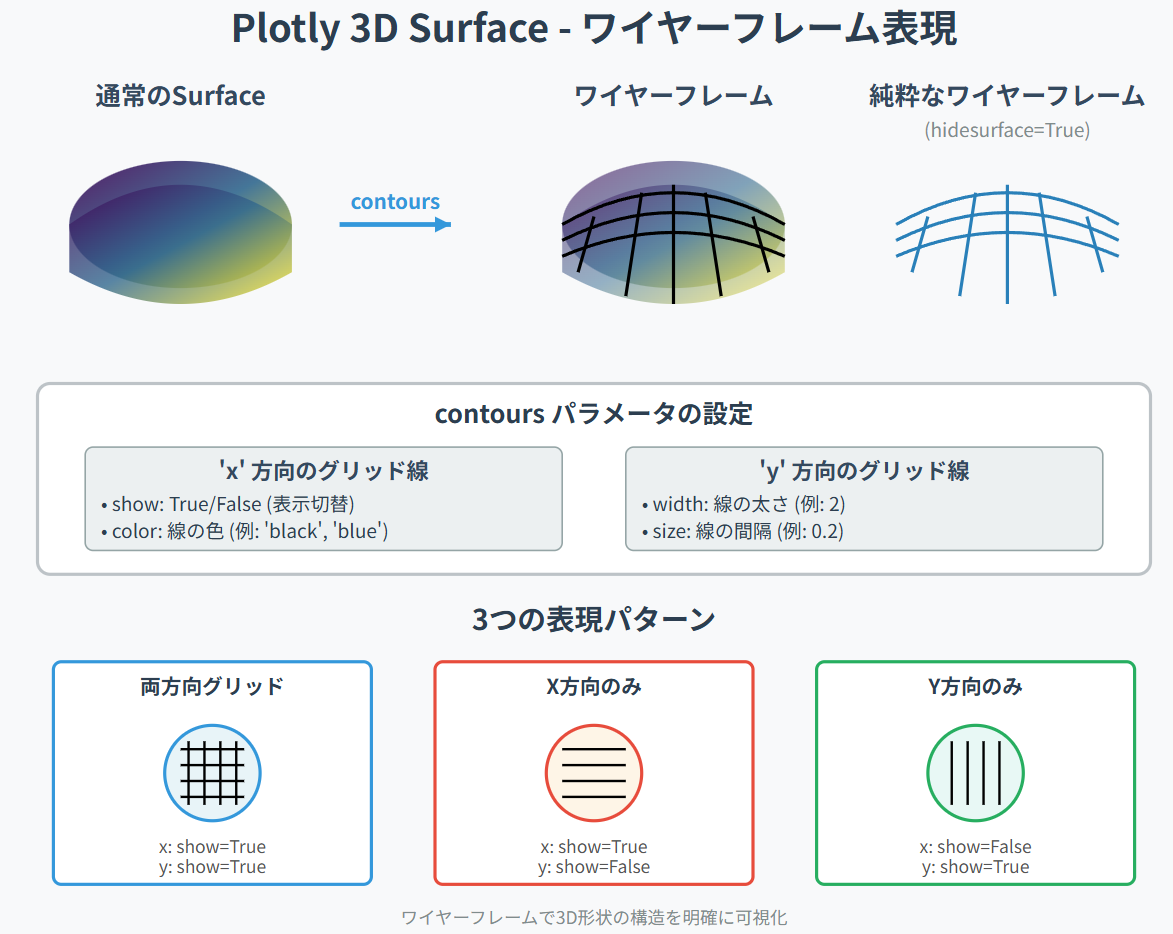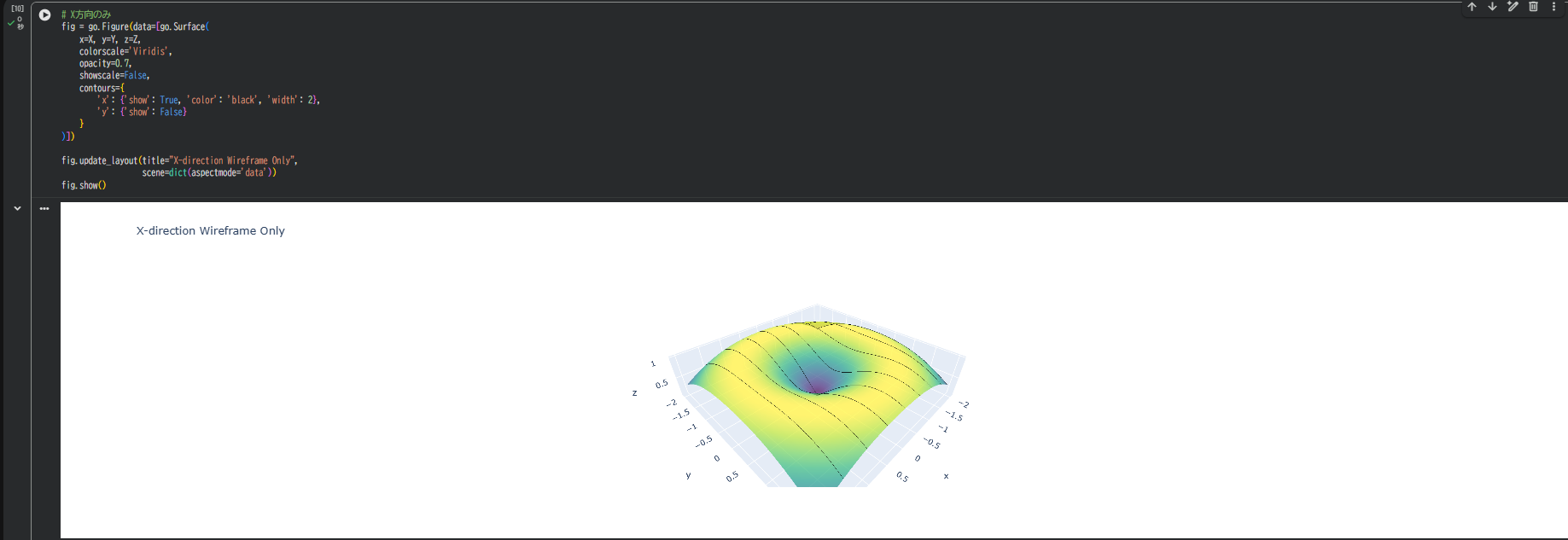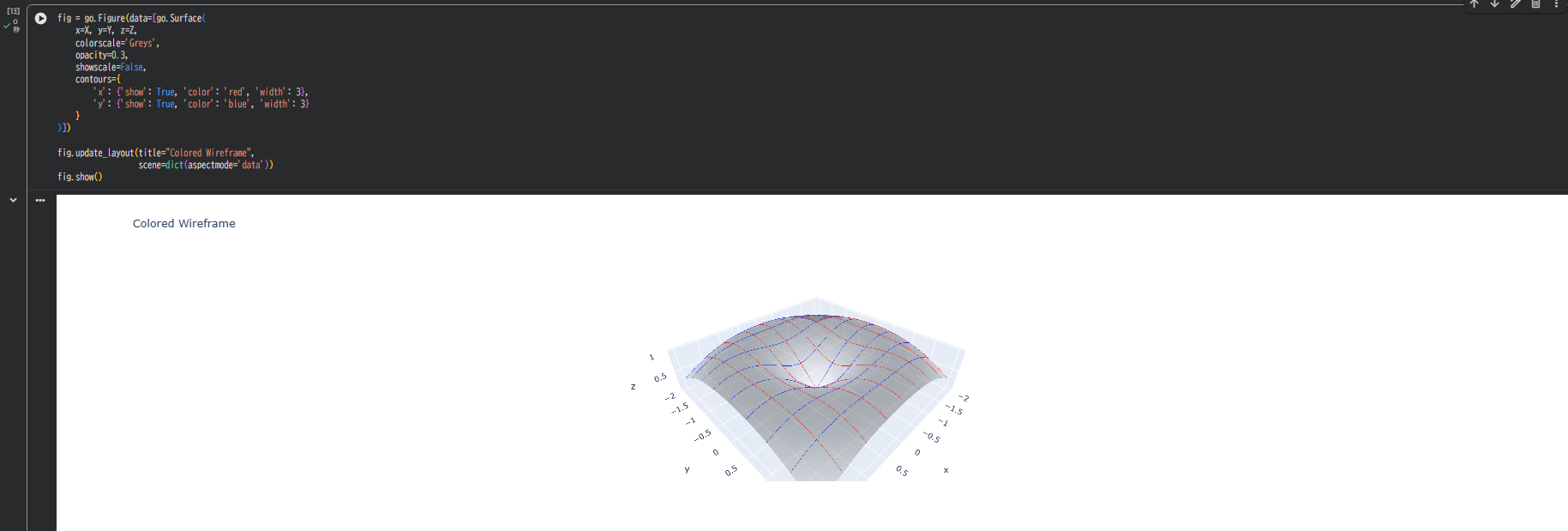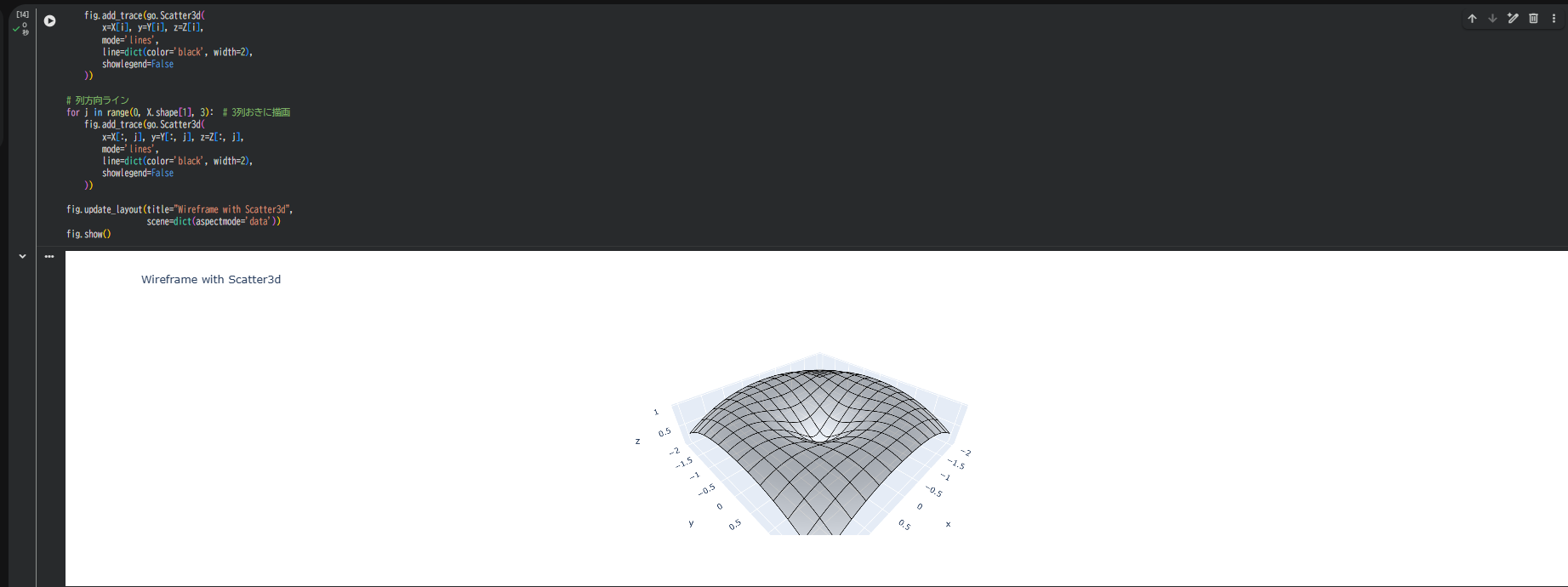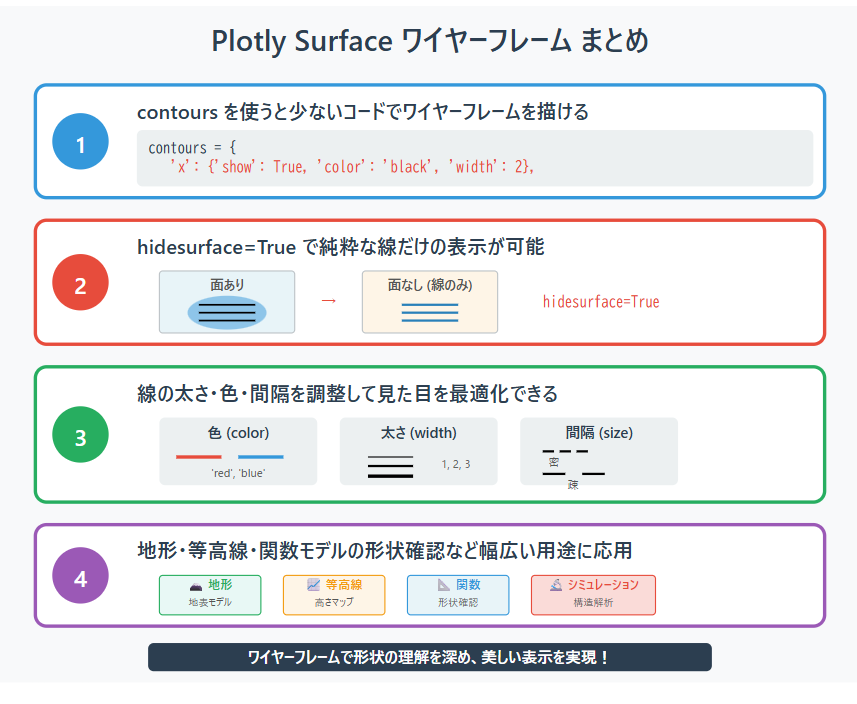はじめに
Surface(3D曲面)は、通常は滑らかな色面で表示されますが、
ワイヤーフレーム表示 にすると"形状の構造"が直感的に見えるようになります。
等高線・メッシュ・地形モデル・シミュレーションの確認など、用途は非常に広いです。
今回は、PlotlyでSurfaceのワイヤーフレーム(格子線)を描く方法を整理します。
この記事でできること
- Surfaceを「ワイヤーフレーム」風に描画する
- 面と線の組み合わせで3D形状を明確にする
- 地表モデル・関数形状・高さマップなどに応用
- Colabでそのまま動くコード付き
1. 基本となるSurfaceを描く
まずは通常の3D Surfaceを表示します。
import plotly.graph_objects as go
import numpy as np
# データ生成
x = np.linspace(-2, 2, 40)
y = np.linspace(-2, 2, 40)
X, Y = np.meshgrid(x, y)
Z = np.sin(np.sqrt(X**2 + Y**2))
fig = go.Figure(data=[go.Surface(
x=X, y=Y, z=Z,
colorscale='Viridis',
showscale=False
)])
fig.update_layout(title="Base Surface", scene=dict(aspectmode='data'))
fig.show()
2. 標準機能でワイヤーフレームを表示する
Plotlyのgo.Surfaceには、ワイヤーフレーム機能が用意されています。
contoursパラメータを使用することで、簡単にワイヤーフレームを描画できます。
2-1. 基本的なワイヤーフレーム
fig = go.Figure(data=[go.Surface(
x=X, y=Y, z=Z,
colorscale='Viridis',
showscale=False,
contours={
'x': {'show': True, 'color': 'black', 'width': 2},
'y': {'show': True, 'color': 'black', 'width': 2}
}
)])
fig.update_layout(title="Surface with Wireframe",
scene=dict(aspectmode='data'))
fig.show()
X方向とY方向の両方にグリッド線が描画され、メッシュ構造が明確になります。
2-2. 純粋なワイヤーフレーム(面を非表示)
fig = go.Figure(data=[go.Surface(
x=X, y=Y, z=Z,
hidesurface=True, # サーフェスを非表示
contours={
'x': {'show': True, 'color': 'blue', 'width': 2},
'y': {'show': True, 'color': 'blue', 'width': 2}
},
showscale=False
)])
fig.update_layout(title="Pure Wireframe",
scene=dict(aspectmode='data'))
fig.show()
hidesurface=Trueを指定することで、線だけの純粋なワイヤーフレームになります。
2-3. 片方向だけのワイヤーフレーム
# X方向のみ
fig = go.Figure(data=[go.Surface(
x=X, y=Y, z=Z,
colorscale='Viridis',
opacity=0.7,
showscale=False,
contours={
'x': {'show': True, 'color': 'black', 'width': 2},
'y': {'show': False}
}
)])
fig.update_layout(title="X-direction Wireframe Only",
scene=dict(aspectmode='data'))
fig.show()
必要に応じて、片方向だけのグリッド線も表示できます。
3. グリッド線の詳細設定
3-1. 線の間隔を調整
fig = go.Figure(data=[go.Surface(
x=X, y=Y, z=Z,
hidesurface=True,
contours={
'x': {
'show': True,
'color': 'darkblue',
'width': 2,
'start': -2,
'end': 2,
'size': 0.2 # グリッド線の間隔
},
'y': {
'show': True,
'color': 'darkblue',
'width': 2,
'start': -2,
'end': 2,
'size': 0.2
}
},
showscale=False
)])
fig.update_layout(title="Wireframe with Custom Spacing",
scene=dict(aspectmode='data'))
fig.show()
sizeパラメータでグリッド線の密度を調整できます。
3-2. 色や太さのカスタマイズ
fig = go.Figure(data=[go.Surface(
x=X, y=Y, z=Z,
colorscale='Greys',
opacity=0.3,
showscale=False,
contours={
'x': {'show': True, 'color': 'red', 'width': 3},
'y': {'show': True, 'color': 'blue', 'width': 3}
}
)])
fig.update_layout(title="Colored Wireframe",
scene=dict(aspectmode='data'))
fig.show()
X方向とY方向で異なる色を指定することも可能です。
4. 別の方法:Scatter3dを使ったワイヤーフレーム
公式機能以外に、Scatter3dを重ねる方法もあります。
より細かい制御が必要な場合に有効です。
fig = go.Figure()
# 面(薄く表示)
fig.add_trace(go.Surface(
x=X, y=Y, z=Z,
colorscale='Greys',
opacity=0.3,
showscale=False
))
# 行方向ライン
for i in range(0, X.shape[0], 3): # 3行おきに描画
fig.add_trace(go.Scatter3d(
x=X[i], y=Y[i], z=Z[i],
mode='lines',
line=dict(color='black', width=2),
showlegend=False
))
# 列方向ライン
for j in range(0, X.shape[1], 3): # 3列おきに描画
fig.add_trace(go.Scatter3d(
x=X[:, j], y=Y[:, j], z=Z[:, j],
mode='lines',
line=dict(color='black', width=2),
showlegend=False
))
fig.update_layout(title="Wireframe with Scatter3d",
scene=dict(aspectmode='data'))
fig.show()
この方法は、特定の行・列だけを選択して描画したい場合に便利です。
5. 背景や軸の調整(見やすさUP)
fig.update_layout(
scene=dict(
xaxis=dict(backgroundcolor='rgb(245,245,245)', gridcolor='white'),
yaxis=dict(backgroundcolor='rgb(245,245,245)', gridcolor='white'),
zaxis=dict(backgroundcolor='rgb(250,250,250)', gridcolor='white'),
aspectmode='data'
)
)
まとめ
contours を使うと、少ないコードでワイヤーフレームを描ける。
hidesurface=True を指定すれば、純粋な線だけの表示も可能。
線の太さ・色・幅を調整することで見た目を最適化できる。
地形や等高線、関数モデルの形状確認など幅広い用途に応用しやすい。
ワイヤーフレームは形状の理解にとても便利で、美しい表示を作れるのが魅力です。
参考情報
